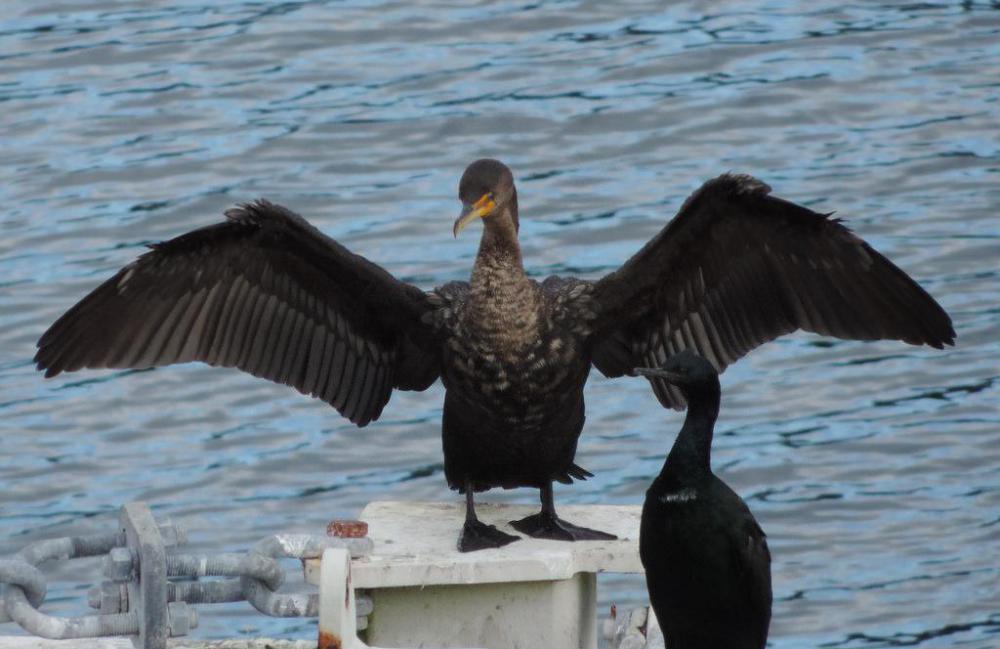At AllThingsNature, we're committed to delivering accurate, trustworthy information. Our expert-authored content is rigorously fact-checked and sourced from credible authorities. Discover how we uphold the highest standards in providing you with reliable knowledge.
What are Shags?
Shags are close relatives of cormorants, found on the sea coasts of many regions around the world. In fact, cormorants and shags are in the same biological genus, Phalacrocorax, and the differences between cormorants and shags are not hard and fast. Some species are referred to by either name, depending on where they are being discussed, and the birds are obviously closely related genetically, given that they are in the same genus.
Because the difference between shags and cormorants is somewhat nebulous and both names are sometimes applied to one bird, identifying shags can be frustrating. One rule of thumb is that shags produce distinctive shaggy crests on their heads during breeding season, while cormorants do not. The breeding season for shags is also longer than that of cormorants. However, some birds which grow crests are called cormorants anyway, and some “shags” don't produce crests; this confusion is probably due to variable reports from early explorers who would have seen the birds at differing life stages and given them common names which became too well-used to be discarded.

Shags are marine birds, and unlike many birds which are considered cormorants, they live exclusively by the seashore, rarely traveling inland. Many shags nest on exposed sea stacks and rocky outcroppings, building large and messy nests of seaweed and scrap materials which are bound together with guano. Visiting a community of shags can be quite an assault on the nose, as the birds produce notoriously stinky guano thanks to their fish-heavy diets.
As a general rule, birds which are considered to be shags are smaller than cormorants, with narrower beaks and leaner bodies. They are also better divers than cormorants, and they may be able to dive deeper than any other bird, according to studies conducted by ornithologists. Shags are what are known as benthic feeders, meaning that they collect food from the sea floor, so it is important for them to be able to make deep dives. Many shags also have patches of bright color on their necks and wings.
Shags are especially common in Europe, especially in Britain, where one species, the European or Common Shag, as quite abundant. This species is also sometimes referred to as the Green Cormorant, due to the green tinge which its feathers acquire during breeding season. Shags are also found in New Zealand, where several species including the Bronze Island Shag and the King Shag are endangered due to habitat destruction and a limited range.
Frequently Asked Questions
What exactly are shags?
Shags are medium to large seabirds belonging to the cormorant family Phalacrocoracidae. They are characterized by their elongated bodies, long necks, and slender bills. Shags are known for their impressive diving ability, using their webbed feet to propel themselves underwater in search of fish, their primary diet.
How do shags differ from cormorants?
While shags and cormorants are closely related, shags typically have a more slender build and a longer, more curved bill. Additionally, shags often have crests or tufts on their heads during the breeding season, which most cormorants lack. Behaviorally, shags tend to be more maritime and are less likely to be found inland compared to cormorants.
Where can shags be found?
Shags are predominantly found along rocky coastlines, especially in the colder waters of the Northern Hemisphere. They breed on cliffs, islands, and in coastal caves, with some species being quite specific to certain geographic locations. For instance, the European shag is largely found around the coasts of western and southern Europe and the Mediterranean.
What is the breeding behavior of shags?
Shags are colonial breeders, often nesting in large groups on cliffs or rocky outcrops. They build nests out of seaweed, twigs, and other marine debris. During the breeding season, they develop distinctive plumage features such as crests and brighter gular patches, which play a role in courtship displays and mate selection.
Are shags endangered?
The conservation status of shags varies by species. Some, like the European shag, are classified as Least Concern by the IUCN, indicating stable populations. However, certain species or populations may be at risk due to factors like oil spills, overfishing, and habitat loss, necessitating monitoring and conservation efforts to ensure their survival.
How do shags adapt to their aquatic environment?
Shags have several adaptations for their aquatic lifestyle. Their webbed feet make them excellent swimmers, and they have special glands to secrete oil for waterproofing their feathers. Their eyes are adapted to see clearly underwater, and they can dive to impressive depths to catch fish, staying submerged for over a minute if necessary.
AS FEATURED ON:
AS FEATURED ON:











Discuss this Article
Post your comments